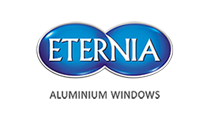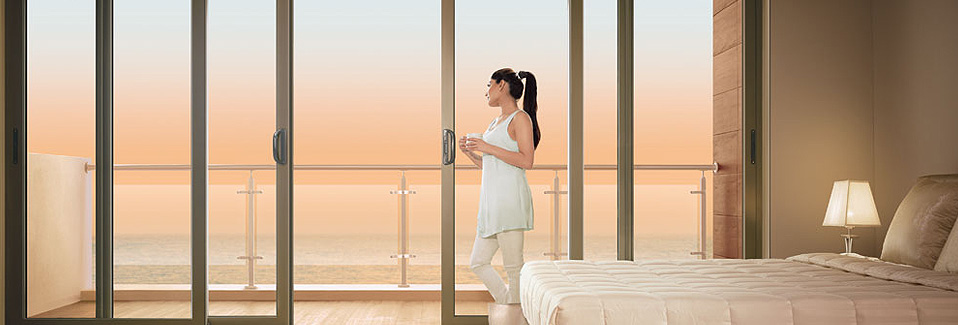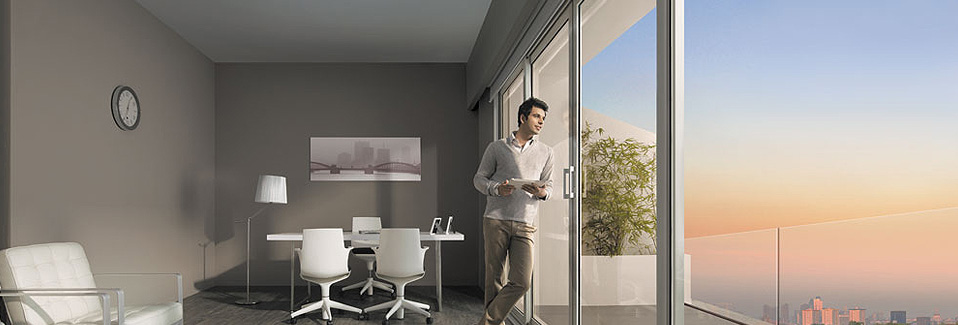
Glass can perform many different roles to make your home more comfortable, more secure, more private or more practical. In fact, glass is an attractive alternative to many other materials, such as wood, brick or polycarbonate.
To choose a glass in your window there are 3 main areas to consider:
1. Natural Light: Glass should allow natural light to come inside while controlling UV and glare.
2. Solar Hear gain: A performance glass helps in keeping heat out and reduces the air-conditioning cost.
3. Thermal Conductivity: Heat flows relatively easily through ordinary glass. In low winter temperatures, modern performance glass dramatically reduces heat loss to the outside, saving on heating costs while reducing greenhouse gases.
Our Doors & Windows support large variety of Glass :
Float Glass
Float glass gets its name from the modern process used to create large, thin, flat panels from molten glass. The molten glass is passed onto a pool of molten tin. This process produces a very smooth piece of glass with a highly consistent thickness.
Annealed Glass
Annealed glass is a piece of float glass that has been cooled in a slow and controlled manner. This slow cooling process reduces the internal stresses within the sheet of glass so that it becomes stronger. Float glass is generally annealed and is the starting point for further treatment. Annealed glass will break into large and sharp shards or pieces. Due to safety concerns, annealed glass is rarely used in buildings.
Heat Strengthened Glass
Heat strengthened glass is made from a sheet of annealed glass that is reheated beyond its annealing point of about 1200 degrees Fahrenheit and then cooled rapidly, but not as rapidly as tempered glass. Since it isn't cooled as quickly, the compressive and tensile stresses aren't quite equal across a section of glass. Therefore, the glass is only about twice as strong as annealed glass. Heat strengthened glass will break into smaller pieces than annealed glass, but these pieces may still be sharp and can cause injury. For this reason, heat strengthened glass is not considered to be safety glass. Heat strengthened glass is rarely used in buildings except when it is laminated.
Fully Tempered Glass
Tempering is a process that takes a piece of annealed glass and makes it four times as strong. After annealed glass is cut and finished to size (tempered glass cannot be cut), it is heated past its annealing point of about 1200 degrees Fahrenheit. Then, the glass is very rapidly cooled, which allows the internal portion of the glass to remain fluid for some time. Since the center stays fluid longer than the outer surfaces, an equal amount of tensile and compressive stresses are formed across the glass, which makes it significantly stronger. Fully tempered glass is a safety glass that will shatter into small granular pieces, which reduces the risk of injury. Tempered glass is ideally used as a safety glass where the glazing may need to be broken out of the frame in an emergency. For instance, the side windows of a car are tempered so that they can be broken away in the event of an accident.
Laminated Glass
Laminated glass is made by fusing two or more layers of glass with inter-layers of polyvinyl butyral (PVB) through the use of heat and pressure. The process creates a safety glass.
If the laminated glass is made using sheets of heat strengthened glass, then the sheet of glass will break into large pieces, but it will be held in the frame by the PVB inter-layer. This provides safety, but also adds a level of security since the glass remains in place and prevents a person or object from passing through.
If the laminated glass is made using sheets of tempered glass, then the sheet will fall out of the frame, but will mostly stay together due to the PVB inter-layer. The glass looks a lot like a wet blanket when shattered.
Laminated glass is best used as a safety glass where the glazing must remain intact if it is broken - either for safety or security. For instance, the windshield of a car is laminated heat-strengthened glass so that if an object hits it, the object won't pass through and injure an occupant nor will the glass shatter into the faces of the occupants.
Insulated Glass Unit (IGU)
Insulated glass units (IGU) are built-up assemblies where two pieces of glass are separated by a spacer - this is referred to as double-glazing. Triple-glazing is becoming more common and is made of three pieces of glass and two spacers. The spaces between pieces of glass can be filled with air or an inert gas, such as Argon. Argon is most common, but Xenon and Krypton are more efficient (and considerably more expensive). The sheets of glass are tempered or laminated for safety, and are generally 1/4" thick with a 1/2" air space. Finally, the most critical component of an IGU is the desiccant, which removes humidity from the cavity to prevent condensation within the IGU.
Double-glazed IGUs made from 1/4" glass and a 1/2" space filled with air have an R-value of around R-2. Changing the air to Argon gas raises the R-value to R-3. Further changing the glass to Low-E, described below, can take the assembly to an R-value of R-4. Finally, a triple-glazed IGU can have a value of R-5 or slightly higher. As always, please refer to manufacturer data for R-values of specific IGUs.
Low-Emissivity Glass
Low-emissivity (Low-E) glass is glass that has a special coating that reflects the infrared portions of light, while letting the visible light spectrum through. This is beneficial because the infrared heat from the sun is reflected away from the building in the summer and during the winter the infrared heat that is already inside a building is reflected back into the space.
There are two general types of Low-E coating, tin or silver. Tin oxide is applied to the glass at high temperatures to create a very hard and durable Low-E coating. The alternative is a silver coating, which must be enclosed in an IGU so that the silver doesn't degrade over time due of oxidation.
Low-E coatings often have a slight blue-green tint, which many architects find unacceptable. Newer Low-E coatings are produced with less tint, but it is important to review product samples daylight at varying angles to fully understand what the aesthetics will be when installed.
To choose a glass in your window there are 3 main areas to consider:
1. Natural Light: Glass should allow natural light to come inside while controlling UV and glare.
2. Solar Hear gain: A performance glass helps in keeping heat out and reduces the air-conditioning cost.
3. Thermal Conductivity: Heat flows relatively easily through ordinary glass. In low winter temperatures, modern performance glass dramatically reduces heat loss to the outside, saving on heating costs while reducing greenhouse gases.
Our Doors & Windows support large variety of Glass :
Float Glass
Float glass gets its name from the modern process used to create large, thin, flat panels from molten glass. The molten glass is passed onto a pool of molten tin. This process produces a very smooth piece of glass with a highly consistent thickness.
Annealed Glass
Annealed glass is a piece of float glass that has been cooled in a slow and controlled manner. This slow cooling process reduces the internal stresses within the sheet of glass so that it becomes stronger. Float glass is generally annealed and is the starting point for further treatment. Annealed glass will break into large and sharp shards or pieces. Due to safety concerns, annealed glass is rarely used in buildings.
Heat Strengthened Glass
Heat strengthened glass is made from a sheet of annealed glass that is reheated beyond its annealing point of about 1200 degrees Fahrenheit and then cooled rapidly, but not as rapidly as tempered glass. Since it isn't cooled as quickly, the compressive and tensile stresses aren't quite equal across a section of glass. Therefore, the glass is only about twice as strong as annealed glass. Heat strengthened glass will break into smaller pieces than annealed glass, but these pieces may still be sharp and can cause injury. For this reason, heat strengthened glass is not considered to be safety glass. Heat strengthened glass is rarely used in buildings except when it is laminated.
Fully Tempered Glass
Tempering is a process that takes a piece of annealed glass and makes it four times as strong. After annealed glass is cut and finished to size (tempered glass cannot be cut), it is heated past its annealing point of about 1200 degrees Fahrenheit. Then, the glass is very rapidly cooled, which allows the internal portion of the glass to remain fluid for some time. Since the center stays fluid longer than the outer surfaces, an equal amount of tensile and compressive stresses are formed across the glass, which makes it significantly stronger. Fully tempered glass is a safety glass that will shatter into small granular pieces, which reduces the risk of injury. Tempered glass is ideally used as a safety glass where the glazing may need to be broken out of the frame in an emergency. For instance, the side windows of a car are tempered so that they can be broken away in the event of an accident.
Laminated Glass
Laminated glass is made by fusing two or more layers of glass with inter-layers of polyvinyl butyral (PVB) through the use of heat and pressure. The process creates a safety glass.
If the laminated glass is made using sheets of heat strengthened glass, then the sheet of glass will break into large pieces, but it will be held in the frame by the PVB inter-layer. This provides safety, but also adds a level of security since the glass remains in place and prevents a person or object from passing through.
If the laminated glass is made using sheets of tempered glass, then the sheet will fall out of the frame, but will mostly stay together due to the PVB inter-layer. The glass looks a lot like a wet blanket when shattered.
Laminated glass is best used as a safety glass where the glazing must remain intact if it is broken - either for safety or security. For instance, the windshield of a car is laminated heat-strengthened glass so that if an object hits it, the object won't pass through and injure an occupant nor will the glass shatter into the faces of the occupants.
Insulated Glass Unit (IGU)
Insulated glass units (IGU) are built-up assemblies where two pieces of glass are separated by a spacer - this is referred to as double-glazing. Triple-glazing is becoming more common and is made of three pieces of glass and two spacers. The spaces between pieces of glass can be filled with air or an inert gas, such as Argon. Argon is most common, but Xenon and Krypton are more efficient (and considerably more expensive). The sheets of glass are tempered or laminated for safety, and are generally 1/4" thick with a 1/2" air space. Finally, the most critical component of an IGU is the desiccant, which removes humidity from the cavity to prevent condensation within the IGU.
Double-glazed IGUs made from 1/4" glass and a 1/2" space filled with air have an R-value of around R-2. Changing the air to Argon gas raises the R-value to R-3. Further changing the glass to Low-E, described below, can take the assembly to an R-value of R-4. Finally, a triple-glazed IGU can have a value of R-5 or slightly higher. As always, please refer to manufacturer data for R-values of specific IGUs.
Low-Emissivity Glass
Low-emissivity (Low-E) glass is glass that has a special coating that reflects the infrared portions of light, while letting the visible light spectrum through. This is beneficial because the infrared heat from the sun is reflected away from the building in the summer and during the winter the infrared heat that is already inside a building is reflected back into the space.
There are two general types of Low-E coating, tin or silver. Tin oxide is applied to the glass at high temperatures to create a very hard and durable Low-E coating. The alternative is a silver coating, which must be enclosed in an IGU so that the silver doesn't degrade over time due of oxidation.
Low-E coatings often have a slight blue-green tint, which many architects find unacceptable. Newer Low-E coatings are produced with less tint, but it is important to review product samples daylight at varying angles to fully understand what the aesthetics will be when installed.
© 2013 Riddhi Siddhi . All Rights Reserved.
Design by : Promotech










